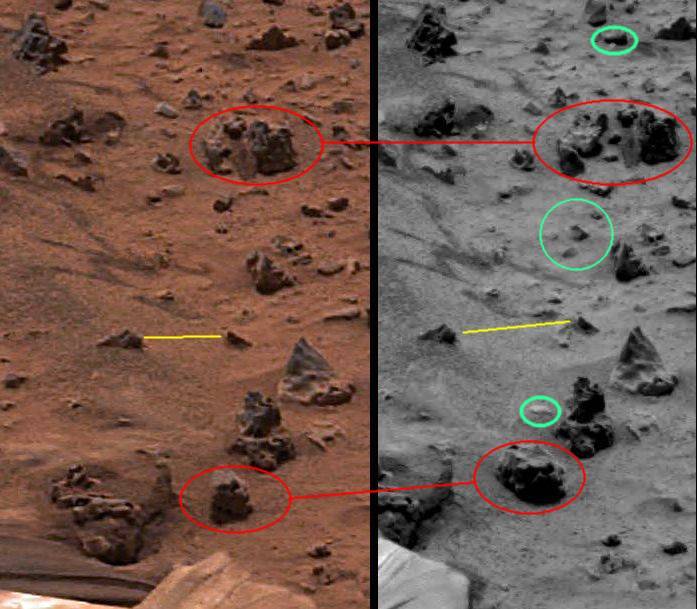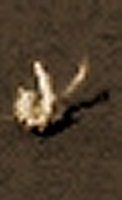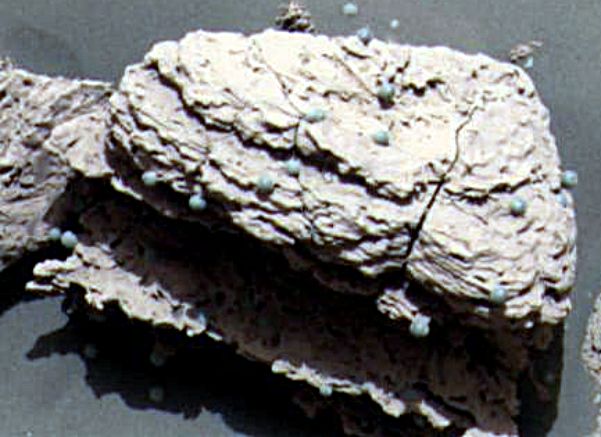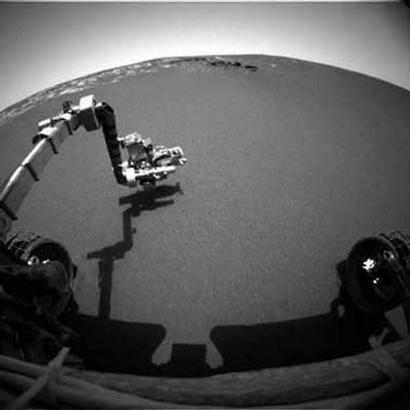Cydonia Quest The Occasional Journal C Entry No. 4 - 22nd February 2004 Weird Science Invades Mars - Part One Before beginning this journal entry on the weird science that has been surrounding the Spirit and Opportunity rover missions, I must confess to my own bit of weird science. In the previous journal entry (published on the day Opportunity landed on Mars) I drew attention to the strange pattern of ridges and hollows on the slope facing Opportunity (see µµµ). In the image this slope looked at least thirty feet high. It turns out that such is the zoom power of the panoramic cameras on the Mars rovers that this slope is only about four to five foot high. It transpired that Opportunity had landed in a small crater. Putting these two things together I think we can safety put the cellular pattern seen on the slope down to the underlying geology of the crater that is one of angular rock slabs. The professional science surrounding the Mars rover missions has sometimes been even weirder. As a case in point "Mikey Mayhem" (a contributor well known to more than one internet conference room discussing Mars anomalies) has drawn my attention to discrepancies between a colour panorama image of the Spirit landing site and five black & White "raw" images subsequently released on the Spirit web page for Sol (day) 5. These discrepancies are shown in the illustration below.
|
| C ccc C The rocks circled in green have disappeared entirely from the colour panorama that was meant to be the prime source of information for image users. The yellow line shows how some rocks have drawn closer together. The rocks circled in red have large parts of them missing! There is no mystery to what has happened here. The colour panorama image is a composite made of smaller images that have been digitally spliced together. It is weird science that JPL should have released a composite image that has been so badly spliced. The line of this digital splicing can be seen by lining up the anomalous missing parts identified in the black & white raw image above. Many image processing packages sold in shops have a facility that allows different images around a scene to be spliced together to create a more panoramic picture. The joins between the composite images are morphed together to hide the joins. However, if the splicing is done badly and parts of the scene are lost this morphing cannot usually hide the resulting discontinuities in the scene. For those in the Mars anomalies community who are "unabashed conspiracy theorists" the worrying thing here is that the morphing in the software that JPL is using is so good that it has been able to cope with such bad splicing. Without comparison with the raw images there is nothing in the published colour panorama to suggest that anything is amiss. So if there actually was a desire to purge anything that looked too much like an alien artefact from an image it would appear to be a frighteningly easy thing to do. It would be just a case of waving a morphing "brush" over the object with the mouse cursor and the surroundings would morph it from the scene leaving no trace. (The colour panorama image described above can be found by clicking here µµµ and the raw images page for Sol 5 here µµµ. It will be interesting to see whether the bad splicing gets corrected). I'm Going to Kill That Wascally Wabbit! This brings us to the weird science surrounding the anomaly at the Opportunity landing site known as "Bunny Ears". This anomaly may have been morphed out of images before the Opportunity rover was instructed to churn up the spot where it was observed. "Bunny Ears" disappearance from panoramic shots was noticed by commentators such as Mac Tonnies, who is not normally all that sympathetic to conspiracy theories (see µµµ). For a conspiracy theorist view of these strange events see µµµ & µµµ. c ccccccccccccccccccccccccccccccccccccccccccc C The "Bunny Ears" anomaly lay straight in front of the Opportunity rover about two feet off course to the left, yet Rover scientists were completely adamant that they weren't going to make the minor course correction necessary to examine it close-up. They were completely confident on the basis of exactly no evidence that it must be something torn off the airbags of the Opportunity, despite it being different in nature from other obvious bits shed off the lander. Given their refusal to waste time examining "Bunny Ears" it is therefore perplexing that the rover team instructed the rover to carry out an even more complex set of manoeuvres that may have ground "Bunny Ears" out of existence. Where the science enters the weird zone is the irrational hostility that the Mars rover team has shown to any suggestion that anomalous things might possibly be interesting in a biological way. This is part of an interview with Professor Ronald Greeley of the Mars rover Science Operations Working Group conducted by the journalist Linda Moulton Howe. Linda Howe: "What about that 'two-horned' white object down below the Opportunity bedrock in one of the pan-cam images? Could the rover pick up the two pronged object to find out what it is?... Dr. Greeley: "No, we can't do that. The arm can't lift weight." LH: "Do you know if they have done anything with the rover to try to go to that spot below the bedrock where the odd 2-pronged object was?" Dr. Greeley: "No, the plan for today was to do a trenching operation with the wheels....But there are no plans to look at that feature you are describing." LH: "I wonder why not because it is so peculiar." Dr. Greeley: "There has not been a lot of discussion of that in the team, so I don't think most of us feel that it amounts to anything." LH: "How can it be dismissed though. What if it is a plant?" Dr. Greeley: "I DON'T WANT TO BRING IT UP, BUT IT'S LIKE THE FACE ON MARS." LH: "But this looks so three dimensional with shadow and everything." Dr. Greeley: "I don't know." (end of interview) The following transcript is part of a another radio broadcast interview between the Mars rovers Principle Investigator Steven Squyres and Linda Moulton Howe (click here µµµ for the whole interview). According to listeners the interview was very relaxed until Howe raised the possibly that mysterious filaments found in the Martian soil by Opportunity's micro-imager might be some kind of life. After that Squyres suddenly became curt to the point of rudeness, with some suggesting that he displayed anxiety. Prof. Steve Squyres: "There is some little filament in this image and we don't know what it is. That's about as far as I'll go. ARE THERE SPECTROMETERS ON THE ARM OF THE OPPORTUNITY ROVER THAT COULD GO DOWN AND TOUCH THIS AREA IF YOU WERE ABLE TO CONTROL IT AND BE ABLE TO TELL IF THERE WERE ORGANIC SIGNALS? SOMETHING WAS ORGANIC LIKE A LIPID OR? No. No. Searching for organics is not part of what we are trying to do in our payload. SO IF IT WERE ORGANIC, THE INSTRUMENTS CURRENTLY COULD NOT... If what were organic? LET'S SAY THESE FILAMENTS WERE SOMETHING ORGANIC. You mean some kind of fabric that we brought with us that was organic in nature like a polymer of some sort? NO, WHAT IF THEY WERE INDIGENOUS TO MARS AND WERE ORGANIC? I'M JUST TRYING TO UNDERSTAND IF WE ARE ABLE TO DISTINGUISH? I don't even want to go there. WELL, THE BIGGER QUESTION IS: ARE WE ABLE TO TELL ORGANIC VERSUS INORGANIC WITH THE CURRENT ROVERS? As I said, we do not have an instrument on the payload that is tasked for looking for organic molecules. SO IF IT WERE JUST HYPOTHETICALLY IF THE FILAMENTS WERE... Sorry, we're not going there. The problem is if you say, "If it were" then you can immediately take it and run with it in ways I don't intend. So, let's be careful here. OK, AS A SCIENCE REPORTER I'M JUST TRYING TO LOOK AT THESE IMAGES AND JUST FIND OUT IF... I think we are probably looking at stuff that came off or our airbags. IF IT WERE NOT, THOUGH, I WAS JUST TRYING TO FIND OUT HOW YOU COULD DIFFERENTIATE? If it were, given the size scale of these things all we can do is take pictures of them. We cannot measure their composition in any way shape or form. SO DO YOU FIND ANYMORE SOMEPLACE ELSE LIKE OVER AT THE BONNEVILLE CRATER OR SOMETHING, YOU STILL WOULDN'T BE ABLE TO TELL EXACTLY WHAT THEY WERE? There is no way to tell what they are made of. We would be able to image them and to study their shape and morphology. The only ones we have seen so far are very close to where we (Opportunity) landed. LET ME ASK YOU ONE OTHER THING. I WAS TALKING WITH PROFESSOR RICE AND HE SAID THAT HE IS INTERESTED IN THE POSSIBILITY THAT THEY COULD BE SOMETHING LIKE THE VOLCANIC HAIRS OF PELE IN HAWAII. That's certainly a possibility. WOULD THERE BE ANY WAY OF CONFIRMING THAT WITH ANY INSTRUMENTATION? Again, all we can do is take pictures. SO, AT THAT 1 TO 2 MICRON SCALE THAT THEY MAY BE, IT'S NOT REALLY POSSIBLE ON THIS MISSION TO TELL EXACTLY WHAT IF THERE WERE FILAMENTS SOME PLACE ELSE WHAT EXACTLY THEY ARE MADE OF? Again, we do not have spectrometers that can measure the composition of something that small. What we're trying to do with this mission is go to places where we think water might have been present, either as standing water bodies or hydrothermal systems, water percolating around and what have you water percolating through the ground, and see if we can find compelling evidence for that and make inferences about whether that would have been an inhabitable environment. AND IF IT HAD BEEN, IS THERE ANYTHING THAT WOULD STILL BE A RESIDUE IN AN ORGANIC CATEGORY? Again, we do not have on this payload, nor did we intend to, a capability to look for organic molecules. That's not what we're trying to do this mission. IT WOULD BE EXCLUDED IF YOU ARE LOOKING FOR ANCIENT WATER BECAUSE WE KNOW THERE IS WATER ICE AT THE POLES IS THERE A POSSIBILITY THAT THERE COULD BE SOME WEIRD LICHEN OR FUNGI OR ALGAE? SOMEWHERE? I don't even know how to begin to answer a question like that. I'm sorry. BECAUSE? You are talking completely hypothetically. YES, BUT THERE IS WATER ICE AT THE POLES. There is ice. There is solid ice. Life all forms of life that we know on Earth require water in the liquid phase. And that has not been found on Mars yet. I THOUGHT WE HAD ALGAE AT ANTARCTICA IN SOME OF THE STRANGE ICE THERE. In order to um, in order to multiply and to propagate itself, in order to metabolise, life requires liquid water. Now, there are forms of life that can go into dormant phases if they are totally frozen. But in order to have these sort of active biological processes, liquid water is, as far as we know, a requirement. SO IN THESE PARTICULAR MISSIONS, IF THERE WAS SOME HYPOTHETICAL ALGAE OR LICHEN OR SOMETHING I'm sorry, these missions tells us absolutely nothing about hypothetical algae, lichen or anything else. That's not what this is about. I JUST DIDN'T KNOW. THIS IS THE FIRST TIME I DIDN'T KNOW YOU COULDN'T LOOK FOR SOMETHING OF AN ORGANIC MOLECULE LIKE A LIPID. I DIDN'T REALISE THAT. No, that's not part of what we're trying to do on this mission. WILL YOU BE ABLE TO LOOK TO SEE IF THERE ARE ANY MORE OF THESE FILAMENTS ANYWHERE AROUND THERE? We are taking microscopic images everywhere as we go along and if something is there, we'll see it. Again, in this point and time, it's impossible to say these things are even Martian, so I can't say much about them. WHAT ABOUT THAT STRANGE 2-PRONG THING THAT PEOPLE ON THE INTERNET WERE PASSING AROUND AND WERE REFERRING TO AS THE 'PLANT' OR THE 'BUNNY?' Oh, the bunny. The bunny is another one of these things that probably was a piece of airbag or something from material we brought with us. IT'S DISAPPEARED FROM THE PANORAMAS? Yeah, either we ran over it or it blew away one of the two. I'm honestly not sure." c cccccccccc c ................And yet despite not having the time to closely examine "bunny ears", they were able to closely examine the soil in the same general location. Weird science indeed! C ccccccccccccccccccccccccc c µ Click this "Stargate" to return to Journal main page µ Return to the main Mars page
|



